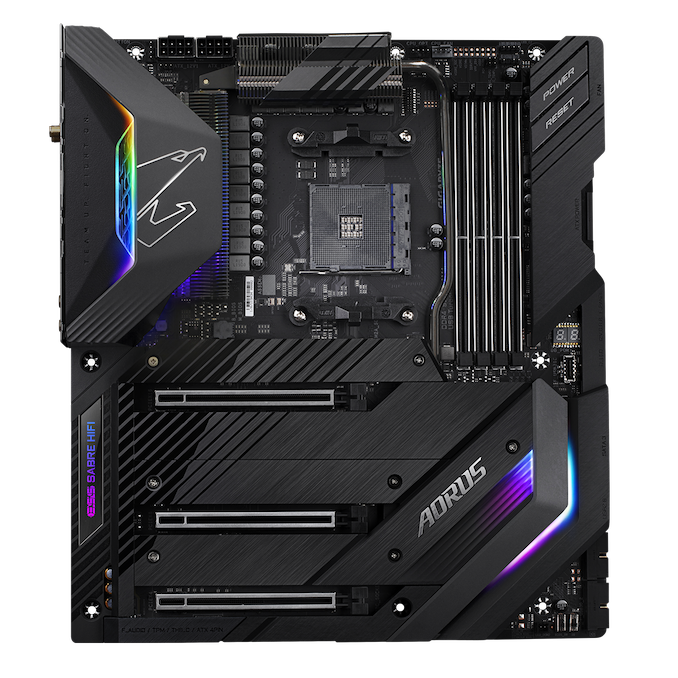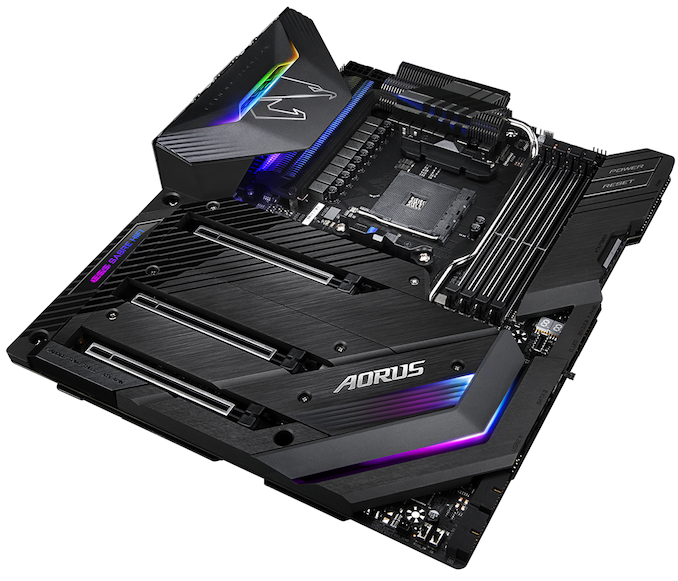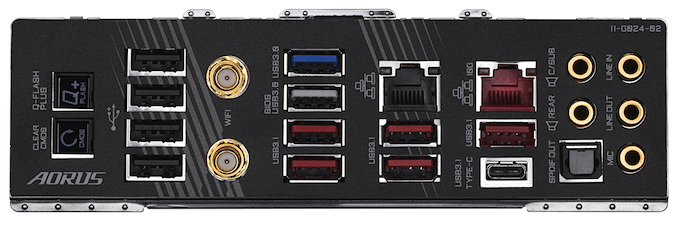The AMD X570 Motherboard Overview: Over 35+ Motherboards Analyzed
by Gavin Bonshor on July 9, 2019 8:00 AM ESTGIGABYTE X570 Aorus Xtreme
Moving onto GIGABYTE's launch day X570 product stack, and it seems to have upped the ante in a number of areas over the previous X470 generation of motherboards. Firstly, GIGABYTE has done a slightly different approach with its power delivery configurations; on paper, they look much higher spec than on previous AM4 models. One prime example of this is in the GIGABYTE X570 Aorus Xtreme which as it stands, is the brand's current flagship model, and is feature-packed with numerous premium componentry, as well as a beefy 16-phase power delivery for the CPU. The other unique feature for the X570 Aorus Xtreme is it's currently the only X570 model at launch to passively cool the warm running X570 chipset.
The X570 Aorus Xtreme is the current flagship from GIGABYTE with a large looking 16-phase power delivery for users looking to overclock the latest Ryzen 3000 series processors, as well as a solid high-end feature set. Across the majority of the PCB, we get Aorus themed armor with three PCIe 4.0 x4 M.2 slots each with its own heatsink which moulds into the PCB cover. There are also six SATA ports with support for RAID 0, 1 and 10 arrays. The CPU VCore section of the power delivery uses two 8-pin 12 V CPU power inputs to deliver power to the processor.
The chipset heatsink onboard the X570 Aorus Xtreme is also one of the only models so far that relies on passive cooling which is interesting as we know the X570 chipset will run with two variants, an 11 W and 15 W. On the rear panel cover is an Aorus Falcon design, with multiple areas with RGB LEDs that users can customize with the Aorus RGB Fusion software. In the top right-hand corner is a power and reset switch, with a small debug LED, and front panel USB 3.1 G2 Type-C port. There are three full-length PCIe 4.0 slots with no PCIe 4.0 x1 slots featured on this model. One of the aspects GIGABYTE is known for focusing on with its high-end models is the onboard audio solution. Adding to the implementation of a Realtek ALC1220 HD audio codec is an ESS Sabre 9218 DAC, with WIMA audio capacitors.
On the rear panel is a large number of inputs and outputs which includes five USB 3.1 G2 Type-A, one USB 3.1 G2 Type-C, two USB 3.1 G1 Type-A, and four USB 2.0 ports. There are two antenna connectors for the integrated Intel AX200 Wi-Fi 6 802.11ax wireless interface, as well as two Ethernet ports which are powered by an Aquantia AQC107 10 G, and Intel I211-AT Gigabit NIC pairing. The Realtek ALC1220-VB HD audio codec adds five 3.5 mm audio jacks and an S/PDIF optical output. Also featured is a clear CMOS switch and Q-Flash Plus BIOS flashing button.
The GIGABYTE X570 Aorus Xtreme is a fine example of what vendors can do for its flagship models on the X570 chipset with plenty of USB 3.1 G2 ports on the rear panel. Dual networking with a 10 G NIC, Wi-Fi 6 capability, and 16-phase power delivery for the CPU make the X570 Aorus Xtreme very attractive. This model has an MSRP of $699 which represents the top end of the X570 product stack at launch, but with everything on offer, it was always expected to be expensive.













225 Comments
View All Comments
The_Assimilator - Wednesday, July 10, 2019 - link
Nope, I really do need that many USB ports! In the past I've used various add-in cards and hubs to achieve this, but my experiences with these devices, and their drivers, and compatibility has been spotty at best, and they also take up space or PCIe slots - hence why I'd much prefer if it was all just integrated on the board.Just to be clear, I don't need 10 USB 3 ports - 8 USB 3 and a pair of 2.0 would be perfect. Considering almost all of these boards have a pair of USB 2.0 headers for 4 ports in total, but cases today don't offer more than a single USB 2.0 front-panel connector - plus that these boards' IO panels have plenty of extra room - I don't see why manufacturers can't drop one of those headers and just give us an extra two rear 2.0 ports as standard.
Qasar - Thursday, July 11, 2019 - link
why not pick up a usb header to slot plate adapter, im sure you have unused card openings on the back of your case under the video cardDanNeely - Wednesday, July 10, 2019 - link
More ports on the back mean fewer available headers for internal connections. x570 has 12 total USB 3.x ports; so most boards maxing out at 8 on the back and 2 headers (2 ports/header) internal seems about right. Going higher means adding either USB3 controller chips (eats PCIe lanes but gives independent ports for greater total system throughput) or on board USB3 hubs; both of which drive up costs. With making the boards PCIe4 capable already driving up costs a lot the board makers are looking to economize elsewhere.shabby - Thursday, July 11, 2019 - link
I noticed the cheap asrock boards have 8 usb3 ports in the back.plonk420 - Tuesday, July 9, 2019 - link
THANK YOU SO MUCH for the VRM information! i don't even OC but i like to keep an eye on what VRMs boards are using... hopefully will help with longevity if i'm going to thrash either Vcore or SoC (keeping components like caps cooler)thomasg - Tuesday, July 9, 2019 - link
In my opinion, all those boards are just silly.All they bring over the 2 years old X370 platform is PCIe 4.0 support, a bit more USB 3 Gen2 as well as often a second m.2 slot.
On the other hand, the southbridge fan is a ridiculous idea, especially consindering all the silly enormous heatsinks they mount to everything BUT the chipset.
And for that, they go for a premium of about 60% over X370 when it was fresh.
I paid 170 dollars for my PRIME X370-Pro day 1 (over 2 years ago), now the successor is 270 dollars.
The WS is the only board looking buyable, but then again, it also is actively cooled and doesn't even bring NBase-T.
I could forgive that, wouldn't they charge well above 300 dollars for it (while the other boards are close to MSRP in germany, the WS is already far below its MSPR).
Nope, thanks, I'm skipping X570.
Death666Angel - Wednesday, July 10, 2019 - link
"I paid 170 dollars for my PRIME X370-Pro day 1 (over 2 years ago), now the successor is 270 dollars."Take that up with ASUS. I can get the X570 Phantom 4 from AsRock with (4x2) power stages (which means easier 3950X oc vs your x370 Pro) for 170€.
And for me, I'm starting to think that having 3 whole x4 slots (2 M.2, one x16) of 4.0 speeds is a nice addition versus the one 3.0 x4 M.2 and one 3.0 x2 or 2.0 x4 slot with another 2.0 x4 slot all the 4xx and 3xx mainboards offer. If I'm spending ~500€ anyway (32GB and 8 core), I might as well just spend another 170 on the mainboard vs 100 on a B450 (I need mATX, so only the MSI Mortar and AsRock Pro4 suite my needs).
And if you need Thunderbolt or over GbE speeds, these boards are the only way to go, frankly, since the 2.0 chipset lanes of the older chipsets are just terrible for this.
This doesn't satisfy your niche? Great, move along. That's the incredible thing about AMD supporting AM4 for this long. But no need to shit over a product that is pretty great overall, just because you don't need it's features.
thomasg - Thursday, July 11, 2019 - link
Indeed, it doesn't satisfy my niche, I'm just complaining about the new downsides of the new X570 platform, and specifically the available implementations.I'm not telling anyone not to get one, anyone who wants to take advantage of the extras is of course free to adopt the new boards.
I think I should be able to freely "shit over a product" as I wish without you having to take personal offense.
fearby - Tuesday, July 9, 2019 - link
Being in a hot climate I'd love to know what one has the best chipset cooling.gavbon - Wednesday, July 10, 2019 - link
We are doing X570 chipset thermal analysis in our motherboard testing ;)